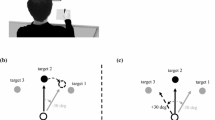Summary
There are different theories, partly contradictory with respect to one another, concerning the mechanism of sensorimotor coordination. From these theories some more or less exact predicitions can be made for the experiment in which the subject experiences in different order a gradual involuntary adaptation to a visual and a tactile sidewards displacement of his right hand. The target tests which were conducted in each case following the adaptation phases, without visual or tactile feedback, show that:
-
1.
After adaptation by means of tactile (proprioceptive) reafference, initially only the pointing to a tactile target (tactile target test) significantly adapts, not, however, the pointing to a visual target (visual target test).
-
2.
After a further like adaptation phase, the pointing to a visual target also attains significant adaptation values, which, however, remain considerably behind (p<0.01) the adaptation measured simultaneously in the tactile target test.
-
3.
If the tactile adaptation occurs immediately after a visual adaptation phase, then only the adaptation values for the tactile target tests (p<0.01) increase in both runs, whereas the values in the visual target tests remain constant or decrease slightly.
-
4.
After adaptation by means of visual reafference, the pointing to a visual target adapts significantly stronger than the pointing simultaneously tested with a tactually presented target.
-
5.
If the visual adaptation occurs after a tactile adaptation phase, then there is an increase only in the adaptation values for the visual target tests in both runs, whereas the values measured in the tactile target tests decrease just as significantly.
The results are discussed in connection with the prediction derived from five hypotheses in the literature. It is then shown that the results correspond best with the values derived from the “Regeltheorie”.
Zusammenfassung
Zum Mechanismus der sensumotorischen Koordination existieren verschiedene, einander zum Teil widersprechende Theorien. Aus ihnen lassen sich hinreichend genau einige Vorhersagen für das vorliegende Experiment machen, in welchem die Vpn in unterschiedlicher Reihenfolge eine unbewußte stufenweise Adaptation an eine visuelle und eine taktile Seitwärtsverschiebung ihrer rechten Hand erfahren. Die jeweils im Anschluß an die Adaptationsphase erfolgenden Zieltests ohne visuelle bzw. ohne taktile Rückkopplung zeigen:
-
1.
Daß nach Adaptation mittels taktiler (propriozeptiver) Reafferenz zuerst nur die auf ein taktiles Ziel gerichtete Zielbewegung (taktiler Zieltest) signifikant adaptiert, nicht aber die auf ein visuelles Ziel gerichtete (visueller Zieltest).
-
2.
Nach einer weiteren gleichen Adaptationsphase erreicht auch die auf ein visuelles Ziel gerichtete Zielbewegung signifikante Adaptationswerte, die jedoch bedeutsam (p<0,01) hinter der gleichzeitig im taktilen Zieltest gemessenen Adaptation zurückbleibt.
-
3.
Erfolgt die taktile Adaptation auf eine visuelle Adaptationsphase, so steigen in beiden Durchgängen nur die Adaptationswerte in den taktilen Zieltests (p < 0,01), während die Werte in den visuellen Zieltests konstant bleiben bzw. leicht abnehmen.
-
4.
Nach Adaptation mittels visueller Reafferenz adaptiert die auf ein visuelles Ziel gerichtete Zielbewegung signifikant stärker als die gleichzeitig geprüfte Zielbewegung auf ein taktil vorgegebenes Ziel.
-
5.
Erfolgt die visuelle Adaptation auf eine taktile Adaptationsphase, so steigen in beiden Durchgängen nur die Adaptationswerte in den visuellen Zieltests, während die in den taktilen Zieltests gemessenen Werte ebenso signifikant abnehmen.
Die Ergebnisse werden im Zusammenhang mit den abgeleiteten Voraussagen von fünf Hypothesen der Literatur diskutiert. Dabei zeigt sich, daß die Ergebnisse den aus der Regeltheorie abgeleiteten Voraussagen am besten entsprechen.
Similar content being viewed by others
Literatur
Becker-Carus, C.: Visumotorisehe Adaptation bei gestörter visueller Rückkopplung eigener Körperbewegungen. Psychol. Forsch. 32, 219–243 (1968).
Efstathiou, A., J. Bauer, M. Greene, and R. Held: Altered reaching following adaptation to optical displacement of the hand. J. exp. Psychol. 73, 113–120 (1967).
Hamilton, C. R.: Intermanual transfer of adaptation to prisms. Amer. J. Psychol., 77, 457–462 (1964).
Harris, C.: Adaptation to displaced vision: visual, motor or proprioceptive change? Science 140, 812–813 (1963).
—: Perceptual adaptation to inverted, reversed and displaced vision. Psychol. Rev., 72, 419–444 (1965).
Held, R., and S. Freeman: Plasticity in human sensorimotor control. Science 142, 455–462 (1963).
Kalil, R. E., and S. J. Freedman: Persistence of ocular rotation following compensation for displaced vision. Perc. Mot. Skills 22, 135–139 (1966a).
— —: Intermanual transfer of compensation for displaced vision. Perc. Mot. Skills 22, 123–126 (1966b).
McLaughlin, S. C., and K. J. Rifkin: Change in straight ahead during adaptation to prism. Psychol. Sci. 2, 107–108 (1965).
Nielsen, T. J.: Volition: A new experimental approach. Scand. J. Psychol. 4, 225–230 (1963).
Pick, H. L., J. C. Hay, and J. Pabst: Kinsethetic adaptation to visual distortion. Paper read at Midwestern. Psychol. Assoc., Chicago, 1963. Nach: Efstathiou et al., 1967.
Author information
Authors and Affiliations
Rights and permissions
About this article
Cite this article
Becker-Carus, C. Verändertes Greifen nach visueller und nach taktiler Adaptation. Psychol. Forsch. 33, 21–36 (1969). https://doi.org/10.1007/BF00424614
Received:
Issue Date:
DOI: https://doi.org/10.1007/BF00424614




